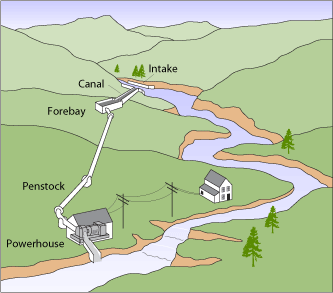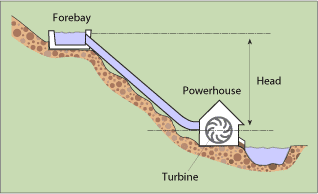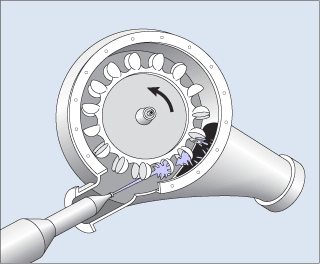microhydropower

Large, hydroelectric dams and generating plants have been used for decades to provide electricity. The same principles can be applied on a much smaller "microhydropower" scale to generate electricity for the homeowner with access to a stream or moving water. This size of system normally produces less than 100 kilowatts of power. A large home or small farm can be adequately powered by a micro-hydro system of only 10 kilowatts.
Microhydropower systems use the energy in moving water to generate electricity. These small systems do not normally rely on reservoirs or dams to impound water but instead use what is referred to as run-of-the river. A portion of a river's water is diverted to a water conveyance – channel, pipeline, or pressurized pipeline (penstock) – that delivers it to a turbine or water wheel. The moving water rotates the wheel or turbine, which spins a shaft. The motion of the shaft can be used for mechanical processes, such as pumping water, or it can be used to power an alternator or generator to generate electricity.
Microhydroelectric systems can only be considered by individuals with access to moving water. In the right situation, however, this approach to energy self-sufficiency can provide more than enough electricity for running a home and may allow the homeowner to sell unused electricity to the utility if the site is grid-connected.
Evaluating a potential microhydropower site
To build a microhydropower system, you need access to flowing water on your property. A sufficient quantity of falling water must be available, which usually, but not always, means that hilly or mountainous sites are best. Other considerations for a potential microhydropower site include its power output, economics, permits, and water rights.
Power output
To see if a microhydropower system would be feasible, you'll want to determine the amount of power that you can obtain from the flowing water on your site. This involves determining these two things:
Once you've calculated the head and flow, then you can use a simple equation to estimate the power output for a system with 53% efficiency, which is representative of most microhydropower systems.
Simply multiply net head (the vertical distance available after subtracting losses from pipe friction) by flow (use U.S. gallons per minute) divided by 10. That will give you the system's output in watts (W). The equation looks this:
net head [(feet) × flow (gpm)] ÷ 10 = W
To help make a microhydropower system more feasible, it's a good idea to make every effort to reduce your electricity usage.
Economics
If you determine from your estimated power output that a microhydropower system would be feasible, then you can determine whether it economically makes sense.
Add up all the estimated costs of developing and maintaining the site over the expected life of your equipment, and divide the amount by the system's capacity in watts. This will tell you how much the system will cost in dollars per watt. Then you can compare that to the cost of utility-provided power or other alternative power sources.
Whatever the upfront costs, a hydroelectric system will typically last a long time and, in many cases, maintenance is not expensive. In addition, sometimes there are a variety of financial incentives available on the state, utility, and federal level for investments in renewable energy systems. They include income tax credits, property tax exemptions, state sales tax exemption, loan programs, and special grant programs, among others.
Permits and water rights
When deciding whether to install a microhydropower system on your property, you also want to know your local permit requirements and water rights.
Whether your system will be grid-connected or stand-alone will affect what requirements you must follow. If your microhydropower system will have minimal impact on the environment, and you aren't planning to sell power to a utility, there's a good chance that the process you must go through to obtain a permit won't be too complex.
Locally, your first point of contact should be the county engineer. Your state energy office may be able to provide you with advice and assistance as well. In addition, in the U.S., you'll need to contact the Federal Energy Regulatory Commission and the U.S. Army Corps of Engineers.
You'll also need to determine how much water you can divert from your stream channel. Each state controls water rights; you may need a separate water right to produce power, even if you already have a water right for another use.
Determining a potential microhydropower site's flow
The quantity of water falling from a potential microhydropower site is called flow. It's measured in gallons per minute, cubic feet per second, or liters per second.
You can use your site's flow calculation along with its head calculation to determine the site's potential power output.
The easiest way (in the U.S.) to determine your stream's flow is to obtain data from these local offices:
If you can't obtain existing data, you'll need to conduct your own flow measurements. You can measure flow using the bucket or weighted-float method.
Bucket method
The bucket method involves damming your stream with logs or boards to divert its flow into a bucket or container. The rate at which the container fills is the flow rate.
For example, a 5-gallon bucket that fills in 1 minute means that your stream's water is flowing at 5 gallons per minute.
Weighted-float method
Another way to measure flow involves measuring stream depths across the width of the stream and releasing a weighted-float upstream from your measurements. Due to water safety concerns, this method isn't recommended if the stream is fast-flowing and/or over your calves.
You will need:
With this equipment you can calculate flow for a cross section of the streambed at its lowest water level.
Instructions:
Stream flows can be quite variable over a year, so the season during which you take flow measurements is important. Unless you're considering building a storage reservoir, you can use the lowest average flow of the year as the basis for your system's design. However, if you're legally restricted on the amount of water you can divert from your stream at certain times of the year, use the average flow during the period of the highest expected electricity demand.
Determining a potential microhydropower site's head
 |
In a potential microhydropower site, head is the vertical distance that water falls. When evaluating a potential site, head is usually measured in feet, meters, or units of pressure. Head also is a function of the characteristics of the channel or pipe through which it flows.
You can use your site's head calculation along with its flow calculation to determine the site's potential power output.
Most microhydropower sites are categorized as low or high head. The higher the head the better because you'll need less water to produce a given amount of power and you can use smaller, less expensive equipment. Low head refers to a change in elevation of less than 10 feet (3 meters). A vertical drop of less than 2 feet (0.6 meters) will probably make a small-scale hydroelectric system unfeasible.
However, for extremely small power generation amounts, a flowing stream with as little as 13 inches of water can support a submersible turbine. This type of turbine was originally used to power scientific instruments towed behind oil exploration ships.
When determining head, you need to consider both gross head and net head. Gross head is the vertical distance between the top of the penstock that conveys the water under pressure and the point where the water discharges from the turbine. Net head equals gross head minus losses due to friction and turbulence in the piping.
The most accurate way to determine gross head is to have a professional survey the site. To get a rough estimate, you can use U.S. Geological Survey maps of your area or the hose-tube method.
Hose-tube method
The hose-tube method involves taking stream-depth measurements across the width of the stream you intend to use for your system – from the point at which you want to place the penstock to the point at which you want to place the turbine. You will need the following:
Instructions:
The sum of these measurements will give you a rough approximation of the gross head for your site.
Note: due to the water's force into the upstream end of the hose, water may continue to move through the hose after both ends of the hose are actually level. You may wish to subtract an inch or two (2–5 centimeters) from each measurement to account for this. It is best to be conservative in these preliminary head measurements.
If your preliminary estimates look favorable, you will want to acquire more accurate measurements. As stated already, the most accurate way to determine head is to have a professional survey your site. But if you know you have an elevation drop on your site of several hundred feet, you can use an aircraft altimeter. You may be able to buy, borrow, or rent an altimeter from a small airport or flying club. A word of caution, however: while using an altimeter might be less expensive than hiring a professional surveyor, your measurement will be less accurate. In addition, you will have to account for the effects of barometric pressure and calibrate the altimeter as necessary.
Microhydropower system components
Run-of-the-river microhydropower systems consist of these basic components:
Commercially available turbines and generators are usually sold as a package. Do-it-yourself systems require careful matching of a generator with the turbine horsepower and speed.
Many systems also use an inverter to convert the low-voltage direct current (DC) electricity produced by the system into 120 or 240 volts of alternating current (AC) electricity. (Alternatively, you can buy household appliances that run on DC electricity.)
Whether a microhydropower system will be grid-connected or stand-alone will determine many of its balance of system components.
For example, some stand-alone systems use batteries to store the electricity generated by the system. However, because hydropower resources tend to be more seasonal in nature than wind or solar resources, batteries may not always be practical for microhydropower systems. If you do use batteries, they should be located as close to the turbine as possible because it is difficult to transmit low-voltage power over long distances.
Microhydropower system water conveyance and filter components
Before water enters the turbine or waterwheel of a microhydropower system, it is first funneled through a series of components that control its flow and filter out debris. These components include the headrace, forebay, and water conveyance (channel, pipeline, or penstock).
The headrace is a waterway running parallel to the water source. A headrace is sometimes necessary for hydropower systems when insufficient head is provided. They often are constructed of cement or masonry. The headrace leads to the forebay, which also is made of concrete or masonry. It functions as a settling pond for large debris which would otherwise flow into the system and damage the turbine.
Water from the forebay is fed through the trashrack, a grill that removes additional debris. The filtered water then enters through the controlled gates of the spillway into the water conveyance, which funnels water directly to the turbine or waterwheel. These channels, pipelines, or penstocks can be constructed from plastic pipe, cement, steel, and even wood. They often are held in place above ground by support piers and anchors.
Dams or diversion structures are rarely used in microhydropower projects. They are an added expense and require professional assistance from a civil engineer. In addition, dams increase the potential for environmental and maintenance problems.
Microhydropower system turbines, pumps, and waterwheels
A microhydropower system needs a turbine, pump, or waterwheel to transform the energy of flowing water into rotational energy, which is converted into electricity.
Turbines
Turbines are commonly used today to power microhydropower systems. The moving water strikes the turbine blades, much like a waterwheel, to spin a shaft. But turbines are more compact in relation to their energy output than waterwheels. They also have fewer gears and require less material for construction.
Only a few companies make microhydropower turbines, and most are high-head turbines. Low-head, low-flow turbines may be difficult to find, and may have to be custom-made.
There are two general types of turbines: impulse and reaction.
Impulse
 |
| Pelton wheels, like this one, can be purchased with
one or more nozzles. Multinozzle systems allow a greater amount of
water to impact the runner, which can increase wheel output.
|
Impulse turbines, which have the least complex design, are most commonly used for high-head microhydro systems. They rely on the velocity of water to move the turbine wheel, which is called the runner. The most common types of impulse turbines include the Pelton wheel and the Turgo wheel.
The Pelton wheel uses the concept of jet force to create energy. Water is funneled into a pressurized pipeline with a narrow nozzle at one end. The water sprays out of the nozzle in a jet, striking the double-cupped buckets attached to the wheel. The impact of the jet spray on the curved buckets creates a force that rotates the wheel at high efficiency rates of 70–90%. Pelton wheel turbines are available in various sizes and operate best under low-flow and high-head conditions.
The Turgo impulse wheel is an upgraded version of the Pelton. It uses the same jet spray concept, but the Turgo jet, which is half the size of the Pelton, is angled so that the spray hits three buckets at once. As a result, the Turgo wheel moves twice as fast. It's also less bulky, needs few or no gears, and has a good reputation for trouble-free operations. The Turgo can operate under low-flow conditions but requires a medium or high head.
Another turbine option is called the Jack Rabbit (sometimes referred to as the Aquair UW Submersible Hydro Generator). The Jack Rabbit is a drop-in-the-creek turbine that can generate power from a stream with as little as 13 inches of water and no head. Output from the Jack Rabbit is a maximum of 100 watts, so daily output averages 1.5–2.4 kilowatt-hours, depending on your site.
Reaction
Reaction turbines, which are highly efficient, depend on pressure rather than velocity to produce energy. All blades of the reaction turbine maintain constant contact with the water. These turbines are often used in large-scale hydropower sites.
Because of their complexity and high cost, reaction turbines aren't usually used for microhydropower projects. An exception is the propeller turbine, which comes in many different designs and works much like a boat's propeller.
Propeller turbines have three to six usually fixed blades set at different angles aligned on the runner. The bulb, tubular, and Kaplan tubular are variations of the propeller turbine. The Kaplan turbine, which is a highly adaptable propeller system, can be used for microhydro sites.
Pumps
Conventional pumps can be used as substitutes for hydraulic turbines. When the action of a pump is reversed, it operates like a turbine. Since pumps are mass produced, you'll find them more readily than turbines. Pumps are also less expensive.
For adequate pump performance, however, your microhydropower site must have fairly constant head and flow. Pumps are also less efficient and more prone to damage.
Waterwheels
The waterwheel is the oldest hydropower system component. Waterwheels are still available, but they aren't very practical for generating electricity because of their slow speed and bulky structure.
